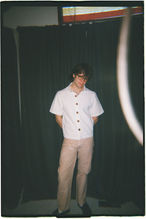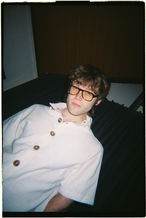
DERIVED!
clothing crafted with care + colored by nature.
product photography by: Abby Wilson
Clothing is more than just fabric—it holds memories, stories, and connections. But somewhere along the way, society lost that. Fast fashion taught people to see clothing as disposable, not meaningful.
My project DERIVED is about returning to intention. It’s about slowing down, embracing natural processes, and finding beauty in imperfection. Born from the Earth and dyed with plants and minerals, this collection is a quiet protest against overconsumption — and a reflection of care — for our planet and for ourselves.


Where color once came from
Before bright synthetic dyes, color came slowly.
From crushed roots. Dried flowers. Bark, bugs, and minerals. Madder gave deep reds. Indigo offered blues. Phoenician sea snails produced a rich Tyrian purple.
Natural dyeing was a craft passed down — thoughtful, textured, rich with meaning.
But in 1856, a synthetic dye called Mauveine changed everything. It was an accident — discovered by chemist William Perkin in a quest for malaria medicine. But it opened the door to mass-produced color. Bright, fast, cheap.




The shift that followed


By the 1900s, natural dyes were mostly replaced.
Craftsmanship faded. Speed became the goal. And the mass production of synthetic dyes and fibers came with consequences we’re still trying to fix.
Factories dumped dye waste into rivers. Petroleum-based fibers flooded the market. People wore synthetic clothing dyed with chemicals they couldn’t name.
the hidden cost of color
Those vivid synthetic colors? They come with a toxic truth.
Heavy metals, formaldehyde, PFAs, and other chemical residues stay on our clothes and touch our skin.
-
Microplastics from polyester are shed with every wash, flowing into oceans and entering our food system.
-
Dye workers are exposed to hazardous chemicals daily, often without proper protection.
-
And once these garments are tossed, they sit in landfills for years—polyester taking anywhere from 20-200 years to biodegrade.



"Within the fashion and textile sector, the single worst contributor to climate change is dyeing and finishing – the processes by which colour and other chemicals are applied to fabrics. These are some of the most polluting industrial processes in the world.
Dyeing and finishing are responsible for 3 percent of global CO2 emissions (predicted to increase to more than 10 per cent by 2050). That is more than the CO2 produced by shipping and aviation combined. It also causes over 20 per cent of global water pollution."
Source: Dyeing for fashion: Why the clothes industry is causing 20% of water pollution, Euro News, 2022


A lovely alternative
natural dyes + natural fibers
DERIVED is a proposal for something better.
A shift—not just in what we wear, but in how we think about clothing.
Natural fibers and dyes are both eco-friendly and human-friendly. These materials break down naturally, breathe better, and feel better on the skin. Ever worn a linen shirt and noticed how much lighter and more breathable it is compared to a polyester-cotton blend? That difference matters.
100 % Natural fibers also don’t leave behind plastic or toxins. Fabrics like hemp, cotton, and linen are skin-safe, biodegradable, and only get softer with time.
Natural dyes—sourced from plants, roots, bark, and minerals—each carry their own character and story. Fading, subtle marks, and specks are part of their beauty. No two pieces are exactly alike. They wear in, not out—and they age with grace.
And in the process, they bring us closer to our roots.



DIVING INTO NATURAL DYES
Before DERIVED, my knowledge of natural dyes was pretty limited. I’d dipped a hand towel in indigo once during a college class, and I knew turmeric could stain clothing... but beyond that, I didn't know a ton about it.
Last summer, my parents visited a little shop in Vancouver called Maiwa. They brought back jars of powdered pigments and plant-dye supplies, and that was the beginning. I turned my apartment kitchen into a chaotic dye studio—madder root and onion skins dusting the countertops, scraps of fabric hanging to dry on cabinet doors.
It wasn’t neat. It wasn’t easy. And it definitely wasn’t clean.
But I was in it—figuring things out as I went, learning by doing, letting the process lead.








The inspiration behind the collection
DERIVED was inspired by the late summer months—when the days are still warm, but you can feel the seasonal shift coming. Golden light stretches a little longer. The air starts to turn crisp in the mornings. It’s a time that feels slow, reflective, and full of quiet change.
I wanted my mood boards to hold those feelings—warmth, ease, and earthiness. Faded yellows. Sun-washed tans. Textures that feel natural and worn-in. Clothing that’s made to layer, to move, and to last.
This project came from a love of natural materials, seasonal transitions, and the beauty in simplicity and timelessness. It’s about creating pieces that feel like they belong to the moment—and age beautifully with time.




from sketch to stitch













After lots of ideation and quick sketching, I landed on ten pieces—classic and simplistic. Timeless tees, a chore jacket, a linen skirt, canvas pants, two peter pan collar blouses, and an oversized raglan. I explored different silhouettes but kept coming back to relaxed forms. The oversized look felt right—easy, comfortable, and made to move.

Protoyping
Flat patterning + digital patterning, and many fit tests with models.

material choice
Every piece in DERIVED was made using 100% organic materials—chosen not just for sustainability, but for how they feel, wear, and last.
-
200 GSM Organic Linen for the Winona Skirt—light, breathable, and effortless.
-
12 OZ Organic Cotton Canvas for the Chore Jacket and Canvas Pants—structured and built to hold shape.
-
Hemp Herringbone for the Ollie Pants—rich texture, soft drape, and full of depth.
-
Hemp + Organic Cotton Jersey for all Tees—soft, breathable, and easy to live in.
-
Organic Cotton Slub for the Blouses—slightly textured with a relaxed feel.
The Milo Raglan Tee is finished with organic cotton trim for a clean interior detail, and Codelite buttons—made from repurposed dairy waste—were used throughout the collection as a natural, low-impact alternative to plastic.
All garments were sewn with 100% organic cotton thread, so every part of each piece remains fully biodegradable.
To finish, every hem features simple sashiko-inspired stitching—a hand-sewn technique rooted in Japanese tradition. Originally used to extend the life of garments, sashiko brings both durability and visible mending into each piece, adding texture, strength, and a personal touch.
DERIVED!
This collection was photographed in a beautiful Salt Lake City 1970's home—warm, retro, and nostalgic. I chose the space to reflect the feeling of the clothing: slow, thoughtful, and lived-in. The photos have a quiet stillness to them, with golden tones and layered textures that echo the subtle shift of seasons. I want these pieces to feel comfortable and familiar—and something someone wants to treasure and hold onto forever.
Photography by: Abby Wilson



made with love, craft, and intention
Every part of this process was hands-on—not just design, but dyeing, stitching, and story-gathering. I scoured each fabric, mordanted it, then spent hours building layered, plant-based dye baths with: cochineal, coffee grounds, onion skins, and sumac and quebracho. It was slow. Sometimes unpredictable. But very rewarding.
This is just the start. DERIVED is more than a clothing line—it's a shift in how we approach design and fashion. A practice in care, in curiosity, and honoring the planet. The future of fashion doesn’t have to be fast. It can be made by hand, made with heart, and designed to last.


Made by Madeline Gonzales, Senior Capstone, Outdoor Product Design & Development. Utah State University, Class of 2025.













































































